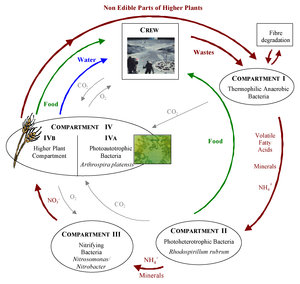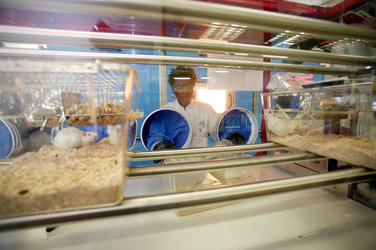How it began
MELiSSA was initially triggered in 1989 by the long-term need to reduce the cargo needed for human missions to the Moon and Mars. People need a lot of machinery and supplies to keep them alive beyond Earth. The solution to this problem was conceived as an artificial ecosystem. Investigating how to make it work encountered many similarities with ground-based environmental problems such as waste and water treatment, so technology developed through MELiSSA also offers solutions to global problems of sustainable development.
Under the impetus of several visionaries – Claude Chipaux and Daniel Kaplan of Matra Espace, Professor Max Mergeay of SCK, Professor Willy Verstraete of the University of Ghent and Professor Marcelle Lefor Tran of CNRS - a group of European organisations sharing common interests decided to pool their efforts in the MELiSSA consortium, formalising their partnership through a joint Memorandum of Understanding signed in 1993.
They defined a long-term vision supported by short to medium term activities which included spin-in and spin-off activities, scientific and practical studies. Short to medium term objectives are regularly revised in terms of results acquired results. In addition, as the project develops, more and more European organisations are contributing to the joint venture, introducing complementary expertise where needed. To date more than 30 organisations from ten different countries have contributed to MELiSSA.
MELiSSA’s benefits
So far this mix of scientific and engineering experts together with users has proved very fruitful, resulting in major scientific outputs - 220 scientific publications and 360 technical notes – and strong progress in our knowledge and understanding of closed life support systems and sustainable development.
As well as innovation, the other key phrases characterising the MELiSSA project are capitalisation and dissemination of knowledge and technology. The aim has been to share the fruits of research and find wider applications for them.
In terms of technology, the step-wise and model-driven progress of MELiSSA has opened up major opportunities for the terrestrial economy. In Europe more than 1.8 million cubic metres of water are treated daily using MELiSSA-based technology for example, and the sparkling wine industry employs a biomass sensor derived from MELiSSA research. Two spin-off companies have been created: IPStar, created in 2005 deals with broad technology transfer from MELiSSA into terrestrial applications while the EZCol pharmaceutical start-up is investigating the broader pharmaceutical potential of cholesterol-lowering micro-organisms employed in the project.
MELiSSA has also brought benefits for science education: more than 100 trainees have spent time on MELiSSA, more than 350 press articles have been written, it has been the subject of many exhibitions and educational activities and around 50 masters and PhD theses have been completed around aspects of its research.
Then there are the near-term space applications, with ESA’s ESTEC facility in the Netherlands becoming the European focal point of efforts to control the International Space Station’s microbial environmental quality and related activities including assessments of bio-contamination on ESA’s Automated Transfer Vehicle.








